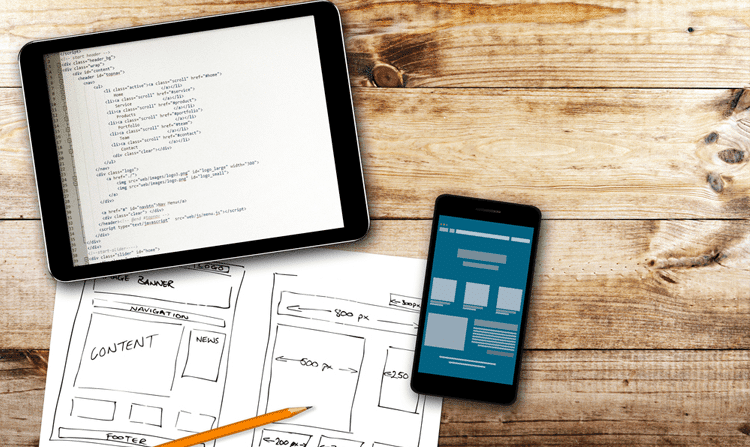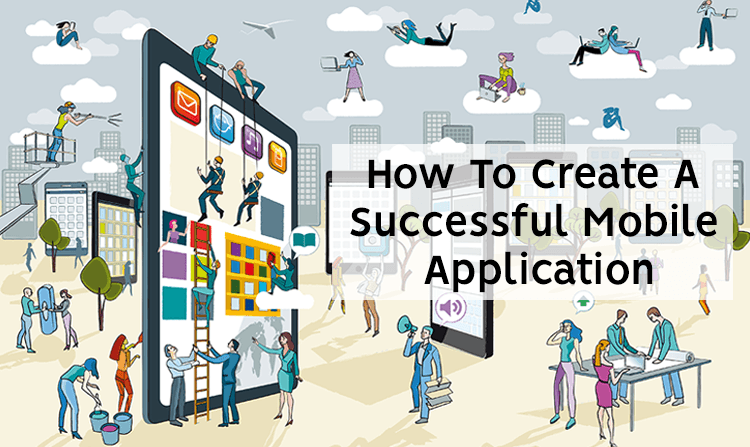The mobile application market is one to marvel at. Google play store now has over 1 million apps in all the major categories. The result is that the application market has become highly competitive and in the midst of such cut-throat competition, it is becoming increasingly difficult for business to get discovered by their potential customer base.
The mobile platform is intrinsic in nature and is one of the most powerful tools of modern society. It is the place where consumers spend most of their time. Therefore, it is imperative to understand the things that result in an effective user experience. The purpose of developing mobile apps should be clear: to deliver applications that satisfy user needs while providing an effective user experience. An application might just perform one function, but it should perform that function effectively.

The mobile application success, therefore, is not a linear process. In order to meet the needs of clients more and more effectively, businesses are constantly updating their applications to improve the user experience, increase their customer base, and reduce their bounce rate.
Where do businesses fail?There is more to an application than engaging in intensive programming and managing venture capital funding. These processes have their place in the application development process, but sometimes we get too caught up in these two activities that we tend to lose sight of our goals and other factors that are really crucial in the development process.

The following article provides an intensive list of the various factors that can impact the creation of a successful application. Hopefully, by the end of this list, you will have a handle on what constitutes a stable mobile application as opposed to an application built in a hurry.
1. Problem Solving
The application that you create will need to solve a problem. This statement is pretty cliche in entrepreneurial circles, but believe it or not, there is a lot of wisdom in this statement. Since mobile applications are used as the primary source of information these days, it is important that our applications solve a user-problem in the easiest manner possible.
Focus on delivering originality and authenticity of information to your product.
When building an application, your primary focus should be on creating either an original application or improving the concept of another application. Most of the applications never make it big because they simply are not solving a real problem or the application is a redesign of an existing application. When you are considering starting up a business, it is important to not get carried away by what is cool, which, unfortunately, most people do.

The question that should always be in your mind is what problem am I trying to solve and will it be useful to society and individuals? The likelihoods of its failure (the higher the better) and the amount of initial funding to get the project up and running should be your secondary concerns. Things like scaling and VC funding come way down the road.
Insightful research might be a bit more than you can chew but the markets will reward your success.
The purpose of the application should be to meet consumer needs. You will only be wasting money building blind applications that are just cool. The coolness factor will simply fade away with time and eventually be irrelevant to users if it does not serve a real-world purpose. It is important, therefore, to conduct research regarding your application and the several barriers it has. The research will result in providing insights, that are general problems, which will help you make your website better.
2. Research
This goes hand in hand with the first step. Research is perhaps the most important of the application creation process. If you think about it logically, what is the point of going neck deep in creating an application only to find out that there is already an application that fulfills the same purpose? You have to understand that you are not the only one coming up with great ideas. Somebody might even release a more stable, and more effective application based on your idea. Therefore, you need to do effective research in order to get inspiration or improve your application even further.

Your primary question when starting out should be “What will make my app different?” It could be value-added, unique informational content, logo content, visually appealing images, and videos, basically, anything that can help you distinguish yourself from the competition. Even your ability to market your product can have a profound effect on your application.
The more time you spend scouring your competition and searching for holes in your competitors' products, the more you will understand what you need to do. In a nutshell, the more the research the clearer will be your goals and objectives.
3. Core Features
The best applications out in the market have one primary similarity with each other. They perform one function and they do it very well. Applications focused on a particular niche perform a lot better than applications that aim for “multi-purpose” use and end up going all over the place. This factor runs hand in hand with the content of a website. The more niche-focused it is, the better it will fare in Google's search engine ranking. So there is an impact when you focus on a core feature.
Another advantage of building a niche-focused application is that it can maximize your resources to deliver a top of the line product and deliver a single, yet effective product.

Your focus should be on what is driving you to create an application in the first place. The idea should be enough of a benchmark to identify where your application will stand in the market. The more unique your idea, the better it will fare when you are trying to build an application around it. The value that your application will create will be compelling enough for your customers.
The most successful applications are the ones that perform their purpose differently compared to the competition. You should focus on the stability of the application architecture first. The extra features can be later added on the request of users in later versions, but a solid foundation will prove effective in updating your applications more easily.
4. Deliver Real Value
Mobile applications are the front and center of the tech industry. Tech companies, governments, and individuals all over the world are embracing the benefits of applications. Applications have now become the primary solution for every problem which shows that the saying that “there is an app for everything”, holds true in most cases.

No doubt, businesses are working day and night to increase their market share using applications but the problem is that there are few businesses that do the required research that is imperative to delivering high-quality products. The main problem that brands face is the creation of brand-value. Your application might be unique, built with the utmost care and, solves a real-world problem. But the problem occurs when it fails to retain customer experience and makes them come back for more.
Nowadays, all users require speed and convenience. Users are poor in time, all they want is the speed and convenience. The result is an application that delivers value every step of the way. You must create unique methods of value creation that previously were not available in order to compete in the competitive market. The greater the customer experience you deliver; the better the results you will gain with your application.
5. Planning & Target Audience (Marketing)
The next important phase of your research, which will give you an indication of where you stand comes in the form of marketing. The marketing of the application is a crucial step in creating a successful application. This is also the step where you start asking the questions regarding pricing and subscription fees. Should the application offer in-app purchases or gain additional revenue through ads? Many more similar questions will start popping up once you start pondering the question of marketing your product. A good strategy is to jot down all the questions you have regarding your market and then integrate them in such a manner that it will yield an effective marketing strategy for your business.

It is important that you think about the additional costs that are incurred to market your product. How will people find your product and even consider using your application? How will you create the next best big application in your niche?
You have to be realistic in your approach towards your plan. Locating keywords, SEO targeted content and good social media marketing is the key to the success of your application. The climb will be rather difficult but such attention to detail will result in a popular application. Start small and expand slowly by growing outwards rather than stretching out your resources by only focusing on scaling.
6. Keep It Simple
This has been discussed time and time again, the user experience is a crucial part of your application. The ultimate benefit of good user experience is a reduced bounce rate and increased customer retention. Applications are meant to be minimalistic and give out more information with less clutter. Users love this effect and it is up to you and your team to provide that simplicity with an efficient design and application structure. An app that does not provide a good user experience will eventually be thrown away.

Good navigation and providing users with a clear path to follow will prove tremendous in the success of their application. Convenient navigation based on design guidelines is the best practice when developing an application. Regardless, whatever functionality that you include in your application, if the end result is providing simple user experience, then it would prove very effective.
As discussed before, users simply do not have the time to learn how to use an app. You can either create a fluid design or create prompt up boxes to guide them. The point is to add value to areas where you are lacking. If the app is based on simplicity, users will have no reason to go looking for any competitors.
7. Develop For iOS And Android
In order to gain a competitive edge in the market, your application creation strategy should contain development plans for both iOS and Android platforms, which are currently the two most popular app development frameworks. You can achieve this by using an application development framework that works at a cross-platform level. Using such frameworks, you can reduce the time and cost associated with developing applications separately on both platforms. At the promotional level, you will be able to target two different user-bases, each distinct in their tastes. The costs that you save using the frameworks, you can use on your marketing efforts, which will reap greater benefits in the long run.

8. Application Workflow
Workflow refers to how your application moves from one place to another. This might seem like a rather small and trivial factor but if you think about it, every app that you have ever used has a certain flow designed to it that must have been planned beforehand in order to avoid uncertainty later on. Factors like User Interface and User Experience account for a lot in these situations. If your workflows’ UI/UX is bland and has too little feature or, if it has too many features, people will not see the point in spending their time figuring it out.

The primary concept of an application’s workflow is the idea of the number of screens you will have and what will be on each particular screen. A good workflow is indicated when all the screens are linked together.
Though it may sound something that is not noticed by a user initially, your transition choices are important in your workflow. The feeling of ease and simplicity is the primary feeling you want to convey to your users when they are using your application.
9. Intuitive Navigation
If the workflow is the indication of how you are moving from page to page, then navigation outlines the specific details of how you will move from one page to another. Paying attention to presumably trivial details allows anyone to create intuitive navigation on the application.

The context of the content matters in designing a navigation structure. It might sometimes be better to have multiple navigational elements that lead you to the next page or, in the case of a blog, there could be a “Move to top” navigation or “Read More” button or link that takes you to the blog catalog. For blogs, it is important that you write content that is useful to the user, only then will the users navigate to other areas of the website.
Another useful navigation element, if you are not into text-based navigation, is the use of icons. The use of icons in navigation is to make sure that the users can get to their destination as soon as possible without having to think about where they should click next. In developer jargon, you can integrate front-end tools like font-awesome and Bootstrap icons to help your navigational process. There is a wide variety of fonts available and it is up to you to decide which one would suit your best. A healthy amount of front-end testing is not going to break your site or anything.
10. Provide Offline Functionality
A majority of applications are reliant on internet availability. Even though the internet is available everywhere and is a major part of an application, it is still important that your application should function without the internet as well. Access to offline features and content can provide a significant advantage and makes you foster a positive UX, which is essential for the success of an application.
11. Maintain High Performance
A good performance rating can work wonders for the success of your mobile application. A poor app rating can deter potential leads, count for negative user experience, revenue as well as brand perception. In order to avoid the negative ratings that your applications, it is important that you test it for any possible bugs and flaws. Users will only rate your application as “Good” if it works flawlessly across all channels.

Building and releasing an application is not an easy task. The part where you release it is the first phase of the entire process. After that, you need to continuously test it for bugs and other problems that might arise. A proactive approach to fixing faults, crashes and slow performance is essential to stay on top of things.
12. Test Your App
Beta testing is an essential process for an application. Most of your users might not use your app in the manner that you intended. It is, therefore, important to go through a testing phase to understand exactly how users are testing your application.

Once the user testing phase is complete, you can move towards sharing your application with a larger variety of users for testing. The user testing phase will help you understand customer needs more effectively, understand the variety of uses for the application and, most importantly, outline the bugs in your app. Using these insights can be very useful since you will have the most effective user interface for your application.
13. Offer It Free
The application market is very diverse. While an application that gives you monetary returns is very useful, that would not attract many visitors to your application. Offering the application for free will instead give them a chance to test out your application for what it has to offer without incurring any risk. Almost all apps allow users to download a free version at first. It will increase the number of people who download your application, but there is no guarantee of the success of the application, though people will give it a try.

What you can do with the free version of your software besides hooking people to your app is that you can use ads. What you can do is offer an ad-version for free and then if the users feel that your application is very useful, they will be happy to pay for the ad-free and content-rich version of the application. Some users might even go so far as to purchase a premium version for your site, which makes it useful to have one.
14. Personalize The Experience
Driving the application experience is very important in providing supreme user experience. An app that appeals to users on a personal level can help drive engagement and help in brand conversion. Your chances of deploying an application that gives out a personalized experience can help your user interact with it better and, later on, rate the applications very nicely as well. Therefore, the application that you create must be tailored to the audience's location and usage behavior. Leveraging profile information and insights from the history of the user to segment and deliver bespoke content to the user. This will help your application gain personalized traction that is very useful in creating long-term customers.

15. Plan Ongoing Engagement
Once the mobile application has been launched, it is important to plan how you will be able to engage with other users. You can build a substantial audience by using techniques like in-app messaging and push notifications. They will help you considerably in getting in touch with customers and remind them about the product and services at an optimal time.

In the modern world, consumers want businesses to understand their preferences and keep them in mind when engaging them with products and services. It is important, therefore that whatever functionality you plan to integrate into your app, it should be relevant to the tastes and preferences of the users. You can take advantage of app analytics and on-site data to deliver personalized and relevant messages to users that deliver relevant messages to users based on that data.
16. Provide A Feedback Channel
One of the most common features that rank applications at the top are in-app communication systems. Your application will perform a lot better if you integrate an efficient customer service base for your application. It could be a simple in-app communication system or external customer service. Either way, you will be able to build your brand and improve credibility for it.
Once you deploy your application, the next best thing is to create communication channels for your brand which helps you grow as a customer focused and highly rated and reviewed brand. When you connect with your users using these customer service channels, you are gaining a lot more in terms of reduced bounce rates and app retention. Deploying such a channel can boost your brand significantly by encouraging user communication, which ultimately results in better views. For best results, it is important that we reduce the help processes to a minimum and ensure seamlessness as much as possible.

This form of communication is most prevalent in all of the top ranking apps. An intuitive customer service channel can improve the user experience tenfold. Therefore, it is important to create channels for communication, feedback, ratings, and reviews. When you are allowing users to connect and get help, you can decrease the chances of your application getting bad reviews due to negative user experience and boost app retention.
In order for you to be successful in the application market, it is imperative that you make the process of feedback and reviews as seamless and smooth as possible. Introducing the app with pop-up dialog and getting them to know the processes is an essential tool in getting the users’ attention and keep them on for longer periods of time.
17. Track In-app Analytics
Using data to leverage and check your app behavior and performance is an important tool in measuring the success of your application, gain insights, identify user-behavior and identify the flaws that need to be improved. More specifically, this analytics will help you track downloads and engagement users have with your apps.

In-app analytics help you to determine the point where you can improve your app and gauge which features are gaining the most attention in terms of user engagement. Analyzing the app consumption time of your site is crucial in making further adjustments to your site. Keeping track of these behaviors can help expand user experience extensively and optimize your marketing strategy extensively, removing the apps for future success.
18. Color Scheme
Building an application is not just about programming, there are several other factors involved in an application that can make or break your application building efforts. This is not to say that code is not required. However, if your visual design is not attractive, the only people who will be attracted to your application would be other developers who will just be there to look at the code.

“Color psychology” is a term that has been gaining traction in the past couple of years. It focuses on the color combinations that elicit an emotional and abstract response from the users. Hundreds of articles on color psychology have been published on the internet, which shows that it is a growing search term.
You might be asking, "What does this have to do with applications?". Well, there is a connection. The visual aesthetic of your application can showcase a lot about your application. The first impression that your application leaves is the most important. If you are in a competitive niche, it is very important to differentiate yourselves from the competition, one way to do that is through an attractive color scheme and typography. The idea is to hook the user from the start and it is possibly the most important concept of doing business. You should cater your color scheme to keep users engaged with your application. With a distinctive color scheme, you will have an application that would stand out perfectly in terms of branding. Your colors, however, should be relative to your brand. This helps in creating branding by comparing color identity with the brand.
19. Device Orientation
If you are a human being alive in 2018, there is no doubt that you have interacted with a multitude of applications on a daily basis. But have you ever noticed the change in orientation of the app every time you tilt the screen from landscape mode to portrait mode or vice versa? Is the application designed to suit your orientation preference right? This phenomenon might look simple from the outset but the impact it has on the user base of an application is tremendous and can convert regular users into loyal customers.
An application designed to be responsive to changes in screen sizes is an important aspect of modern app development. Your application, in portrait view, might look like it has been designed perfectly. For example, all of your drop-down menus, your carousel sliders are all built in accordance with the portrait view, you might think that it is perfect. However, the moment you tilt your device and it goes into landscape mode, you will find that the application front-end is all spread out and messed up. Doesn't look as good as it did in portrait mode, did it? This is why device orientation is crucial. You should always keep user preferences in mind when developing the application front-end.
A “mobile-first” approach to development is the most preferred term nowadays and for all the right reasons. Approximately 60% of your traffic on the internet is driven by mobile devices such as tablets and smartphones. How can you possibly begin to complete your application if you have not optimized your site with the mobile-first approach?

Let us explain what a mobile-first design really is. If you are new to the world of programming, this section might prove very useful. The mobile-first approach is creating responsive applications that adjust to the screen of the user (depending on the size of the screen). You have to optimize your application with respect to the orientation that you think your user would prefer. Off-hand, this does not sound very important if your building application for the iOS or the Android platform, but with the growing prevalence of tablets, it is something that is worth consideration. Your app should perform seamlessly with the change of orientation. Such consideration has been proven time and time again to boost the number of users for an application. The more access to the users, the more money, recognition, and downloads your application will net you.
Another important aspect that you have to consider is how far back should you go for the development of software for your application? It is worth noting that not everyone has upgraded to the iPhone X or the brand new Google Pixel. They could have phones with software ranging as far back as the iOS 7. This conjecture simply reinforces the fact that more people you can reach with your software, the wider your user-base would be. What is the end-goal here? To make your application stand out and become popular right?
The flipside to this is choosing too many platforms. Such a platform base will only tire you out in developing an application. However, this is not much of a problem if you have automation tools at your disposal. They will help ease your workflow and help you get the best out of your application. If you are a novice, it is recommended that you gain the help of your development team in this matter.
20. Prototype Your App
When you are finished considering the various design and development aspects of your application, you are prepared for the application prototyping phase. This is the part where you start implementing everything within your design.
Think of prototyping as a “field-test” for your application and how well it performs under a given number of users. The upside to good prototyping is that you get the feel for the application and how well it performs for users. This is an advanced version of the “Testing your app” section above since it involves a wider range of people that you get to interact with.
When you share your application amongst people, you will gain a lot more insight regarding your application and get a feel for its performance. If it performs well during the prototype phase, you will have fewer problems to deal with when you start building the application.
The prototype phase will bring up several questions. Is the application resource intensive? Do users get lost in the application? Is the interface not user-friendly? Is the app lagging? Does it take a lot of time to complete a single task? Are the features of the application not intuitive enough to be understood? Even if you share the application with your friends and family, you might get those answers. However, it is best to take the holistic approach and prototype your app to as many people as possible.
These things would definitely get you on the right track towards and application development. It might not look as simple at first but if you put in the effort, you will benefit.
The prototype phase will also give you insights into the problems regarding both the front-end and the back-end of your site. It will additionally help you in making adjustments to the content and SEO of your site. Remember, if your application prototype is not shown in the SERPs, you are not going to go far. The prototype adjustments would be tricky and will cause you a lot of sleepless nights but you will thank yourself for the effort you put in once you start gaining financially from the application.
21. Web App Integration
Once you are finished with the adjustments of your application and have worked out all the kinks, it is time to consider which platform you want your app to stand on. Is your application suited just for the play store or do you think that it can gain a following in the Apple store as well? If it is suited for both the platforms, what are the other features that you can integrate into your application that can help it run on the aforementioned platforms both online and offline?

The goal is to boost the user experience to the maximum.
You are probably thinking that this is such a tedious job and it might be a waste of time for some. However, if you really think about it, it adds versatility to your design and allows users to access the data even without an internet connection. It provides users with convenience. Indirectly, it gives the user a sense of belonging to the app since it is available on request.
22. Create Regular Updates
Here is the final part of the process. You have done everything to your application. From designing, developing to deploying, you have gone the whole nine yards with your application. You are now gaining a substantial following as a result of your efforts, but what now? Are you just going to serve your users the same old application interface without any new features or updates? Every big company has products that are continuously being updated with better, more robust features and its high time that you start doing it as well.
Imagine how the internet would have been if Adobe had just stuck to the first design of Photoshop they had launched? They would have failed terribly because of the needs of the ever-evolving internet and would have been replaced by someone better, GIMP perhaps? You do not want that to happen to your application, do you? Of course not, it is very important that you read your applications' reviews and use them to make your application better. This does not mean that you read only one review and create an update just for that. It is better to take your time and gather the problems. Once you have analyzed the problems, release an update that takes care of all the problems. Your user base would be thrilled to have a better, more stable version of the application.
Conclusion:Building an application, as you have might have read from the article, is not easy. There are a lot of troughs and crests that you have to endure in order to complete one application. However, nothing good ever comes easy. You need to be patient and proactive with your application building approach and once you take care of everything and finally deploy it, it will be providing you with more than a substantial return on your investment.







